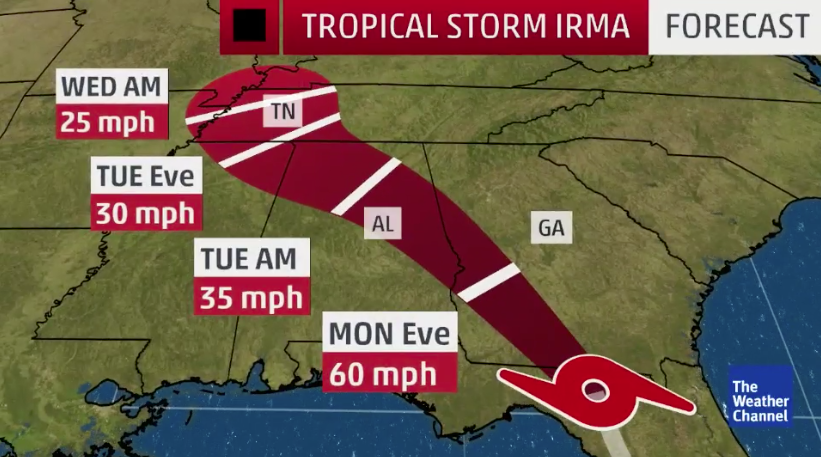After battering Florida, Hurricane Irma moved north into Alabama early on Monday, bringing warnings of strong winds and rain to most of the state.
Irma was downgraded to a tropical storm on Sept. 11 as it moved into southwest Georgia and southeast Alabama. A National Weather Service (NWS) statement said Irma would weaken to a tropical depression later in the day as the system neared Birmingham.
A tropical storm warning remained in effect Monday for counties generally along and east of a line from Troy to Montgomery to Sylacauga to Oneonta. Those counties were expected to receive tropical storm force winds of 30–40 mph with gusts to 55 mph. No tornado activity was expected.
The potential impact of the wind included tree and power line damage. Alabama Power tweeted that power crews were ready to respond to outages, though as of 11 a.m., no widespread outages were reported.
That is not the case in Florida, where an estimated 6.2 million homes and businesses are without power, according to the state’s emergency management division. Florida Power & Light (FPL) deployed nearly 17,000 workers, many from other states, ahead of the storm. Robert Gould, vice president and chief communications officer of FPL, told ABC News that it could take weeks to rebuild the electric grid and restore power to parts of Florida.
Georgia Power mobilized some 3,400 personnel to respond to outages in their state. Officials reported that more than 300,000 customers were without power in the state, with damage and outages primarily concentrated in Central, South and Coastal Georgia.
Damage assessments are ongoing in south Florida. The Miami Herald reported hazards including flooded streets, downed trees, collapsed cranes and leaky homes. Local officials were blocking access to the hard-hit Florida Keys on Monday morning, allowing only utility crews and contractors from the state Department of Transportation to enter the single bridge that connects the islands to the Florida mainland.
Many cities in northern Florida also are dealing with flood conditions, including parts of Jacksonville, Naples and Gainesville. Flooding was a concern in low-lying areas in Alabama as well. The NWS warned that 3 to 5 inches of rain could fall in the tropical storm warning area with locally higher amounts possible. Localized flooding is a possibility.
Alabama Baptist Disaster Relief (DR) units are on standby until Irma’s full impact is known. On Sept. 9 mudout and feeding teams scheduled to go to Texas were asked to stand down and await instructions. Damage assessment in Houston was ongoing this weekend led by Jamie Baldwin and Rick Barnhart from the Alabama Baptist State Board of Missions (SBOM).
DeKalb Baptist Association DR volunteer Anita Clements left Houston Sept. 10 after working in mudout through the weekend. Clements said the combined team from DeKalb and Sand Mountain Baptist associations is already on standby to respond to Hurricane Irma damage.
“We’re just waiting to see where we have to go,” she said.
Mark Wakefield, DR strategist for the SBOM, said volunteers have been preparing for a response to both Hurricane Harvey and Hurricane Irma.
In addition to those already trained, more than 250 new DR volunteers have received emergency DR training since Hurricane Harvey. A training session scheduled for Sept. 11 in Hoover was cancelled due to the impact from Irma and will be rescheduled according to need, Wakefield said. Emergency training will be held at First Baptist Church, Bay Minette, on Sept. 12 and at First Baptist Church, Opelika, on Sept. 24.
Volunteers will likely be called into service as soon as damage assessments can be made in Florida, Wakefield said.
“In Florida, Florida Baptists will be taking the lead in taking care of Florida. Florida Baptists working with the North American Mission Board, FEMA and their own state government will determine where mass feeding units and cleanup units are needed. They’ll assign us a sector and we’ll prepare to go into that area to do what needs to be done,” he said.
In the meantime, Alabama Baptist DR has been asked to provide laundry service for Irma evacuees housed in shelters in Alabama and many local churches and associations are ministering to evacuees as they await word about their homes.
Wakefield said the first thing Alabama Baptists can do is pray for all affected by the hurricane but especially for survivors.
“Survivors have had their whole world washed away,” he said. “As volunteers come in and help them they will be encouragement that God has not abandoned them.”
The second thing is to give. One hundred percent of donations made at SBDR.org/hurricanerelief go directly to SBOM disaster relief work in hurricane stricken areas.
Wakefield said those interested in helping should also look to see what local churches and associations are doing.
“We work though many of the local (Baptist) associations in Alabama to have equipment and teams ready to go.”






Share with others: